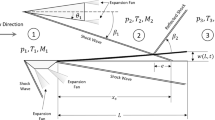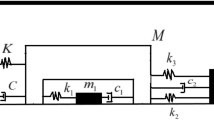Abstract
Purpose
The present work primarily focuses on arriving at an analytical solution for the response of a Coulomb damped harmonic oscillator when subjected to aperiodic excitation.
Methods
The signum function used in modelling the Coulomb friction model is reduced to a first harmonic term. This is carried out by assuming that vibratory motion exists for at least one full cycle, by means of harmonic balance (HB) method. The equation of motion thus reduced is solved to obtain an analytical solution for half-sine, rectangular, and triangular shock inputs. The solution thus obtained is combined with another analytical solution derived by the phase space coordinate averaging method. The total solution is now expressed as a two-part analytical solution, which comprises the response during the action of the input pulse and after the pulse ends.
Results
The analytical results are compared with numerical ones to establish validity and accuracy. A comparison is also made with the experimental readings, and a reasonably good agreement is observed for the response of the oscillator with Coulomb damping. The study is extended further to plot the shock response spectrum (SRS) for the three shock inputs over a wide range of damping values (\(\alpha \)) and frequency ratios (\(\Omega \)). The \(1/2\Omega \) range over which the \(n^\textrm{th}\) peak of the system response is dispersed in the SRS increases with a corresponding increase in \(\alpha \).
Conclusion
The two-part analytical solution proposed here predicts the SRS for the first dominant peak in the vibratory response to a good degree of accuracy and is quantified by directly comparing it with experiment(s).











Similar content being viewed by others
References
Den Hartog JP (1985) Mechanical vibrations. Courier Corporation
Craig Jr, RR, Kurdila AJ (2006) Fundamentals of structural dynamics. Wiley
Rao SS (2001) Mechanical vibrations
Meirovitch L (2010) Fundamentals of vibrations. Waveland Press
De Silva CW (2005) Vibration and shock handbook. CRC Press
Parfitt G, Snowdon J (1962) Incidence and prevention of damage due to mechanical shock. J Acoust Soc Am 34(4):462–468
Tsai TY, Yeh CL, Lai YS, Chen RS (2007) Response spectra analysis for undamped structural systems subjected to half-sine impact acceleration pulses. Microelectron Reliab 47(8):1239–1245
Shu D, Shi B, Meng H, Yap F, Jiang D, Ng Q, Zambri R, Lau J (2006) The pulse width effect of single half-sine acceleration pulse on the peak response of an actuator arm of hard disk drive. Mater Sci Eng A 423(1–2):199–203
Shu DW, Shi BJ, Meng H, Yap FF, Jiang DZ, Ng Q, Zambri R, Lau JH, Cheng CS (2007) Shock analysis of a head actuator assembly subjected to half-sine acceleration pulses. Int J Impact Eng 34(2):253–263
Jayaraman S, Trikha M, Kamesh D, Ravindra M et al (2016) Response spectrum analysis of printed circuit boards subjected to shock loads. Procedia Eng 144:1469–1476
Alexander JE (2009) Shock response spectrum—a primer. Sound Vib 43(6):6–15
Makris N, Chang SP (2000) Response of damped oscillators to cycloidal pulses. J Eng Mech 126(2):123–131
Narkhede DI, Sinha R (2017) Influence of shock impulse characteristics on vibration control using nonlinear fluid viscous dampers. J Vib Control 23(9):1463–1479
Chopra AK (2007) Dynamics of structures. Pearson Education India
Harris CM (2010) Shock and vibration handbook
de Benedetti M, Garofalo G, Zumpano M, Barboni R (2007) On the damping effect due to bolted junctions in space structures subjected to pyro-shock. Acta Astronaut 60(12):947–956
Hundal M (1982) Passive pneumatic shock isolator: analysis and design. J Sound Vib 84(1):1–9
Johnson CD, Wilke PS, Pendleton SC (2006) In Proceedings of the 38th aerospace mechanisms symposium, Langley Research Center, pp 89–102
Tapia-González PE, Ledezma-Ramírez DF (2017) Experimental characterisation of dry friction isolators for shock and vibration. J Low Freq Noise Vib Active Control 36(1):83–95
Shekhar NC, Hatwal H, Mallik A (1999) Performance of non-linear isolators and absorbers to shock excitations. J Sound Vib 227(2):293–307
Ledezma-Ramirez D, Ferguson N, Brennan M (2011) Shock isolation using an isolator with switchable stiffness. J Sound Vib 330(5):868–882
Ismail MI, Ferguson NS et al (2017) Passive shock isolation utilising dry friction. Shock Vib
Ismail MI, Ferguson N (2019) A friction control strategy for shock isolation. Int J Mech Eng Appl 7(3):78–90
Mercer C, Rees P (1971) An optimum shock isolator. J Sound Vib 18(4):511–520
Hartog JD (1930) Lxxiii. forced vibrations with combined viscous and coulomb damping. The London, Edinburgh, and Dublin Philosophical Magazine and Journal of Science 9(59), 801–817
Ferri A (1995) Friction damping and isolation systems
Hundal M (1979) Response of a base excited system with coulomb and viscous friction. J Sound Vib 64(3):371–378
Shaw S (1986) On the dynamic response of a system with dry friction. J Sound Vib 108(2):305–325
Anderson J, Ferri A (1990) Behavior of a single-degree-of-freedom system with a generalized friction law. J Sound Vib 140(2):287–304
Lopez I, Busturia J, Nijmeijer H (2004) Energy dissipation of a friction damper. J Sound Vib 278(3):539–561
Andersson S, Söderberg A, Björklund S (2007) Friction models for sliding dry, boundary and mixed lubricated contacts. Tribol Int 40(4):580–587
Stein GJ, Zahoranskỳ R, Múčka P (2008) On dry friction modelling and simulation in kinematically excited oscillatory systems. J Sound Vib 311(1–2):74–96
Berger E (2002) Friction modeling for dynamic system simulation. Appl Mech Rev 55(6):535–577
Karthik B, Shreesha RB, Shrikanth, V, Gaonkar, AK, Naveen M (2023) Krylov–bogolyubov averaging method-based analytical solution of an unforced nonlinear coulomb damped oscillator. J Vib Eng Technol 1–12
Sawant KR, Shrikanth V (2021) Energy dissipation and behavioral regimes in an autonomous double pendulum subjected to viscous and dry friction damping. Eur J Phys 42(5):055008
Acknowledgements
The authors would like to thank Prof. Amar K. Gaonkar, Department of Mechanical, Materials and Aerospace Engineering, Indian Institute of Technology Dharwad, for his valuable input. The authors would like to thank Science and Engineering Research Board (SERB) for partially funding this work.
Author information
Authors and Affiliations
Corresponding author
Additional information
Publisher's Note
Springer Nature remains neutral with regard to jurisdictional claims in published maps and institutional affiliations.
Rights and permissions
Springer Nature or its licensor (e.g. a society or other partner) holds exclusive rights to this article under a publishing agreement with the author(s) or other rightsholder(s); author self-archiving of the accepted manuscript version of this article is solely governed by the terms of such publishing agreement and applicable law.
About this article
Cite this article
Verma, P.K., Shrikanth, V. A Two-Part Analytical Solution for the Shock Response Spectrum with Coulomb Damping. J. Vib. Eng. Technol. (2024). https://doi.org/10.1007/s42417-024-01307-1
Received:
Revised:
Accepted:
Published:
DOI: https://doi.org/10.1007/s42417-024-01307-1




